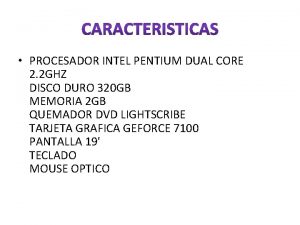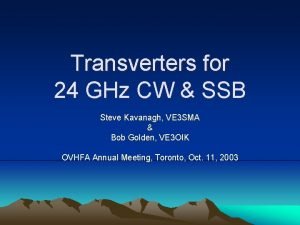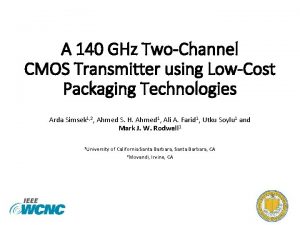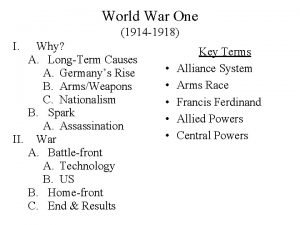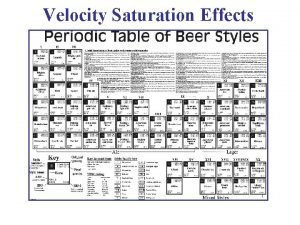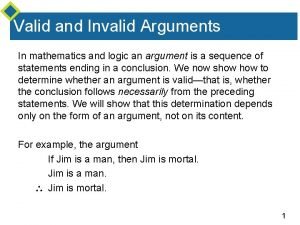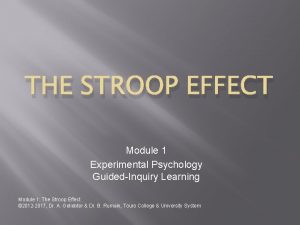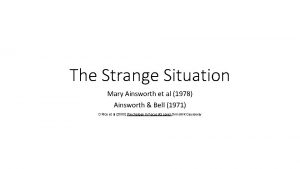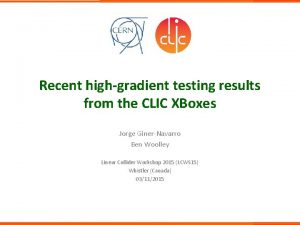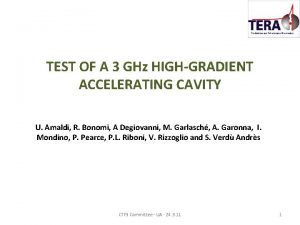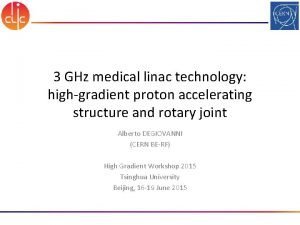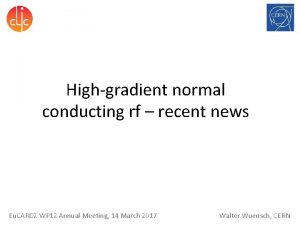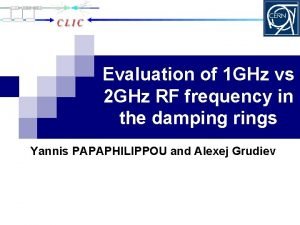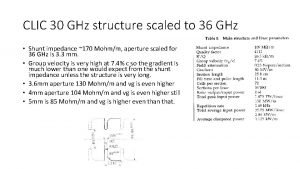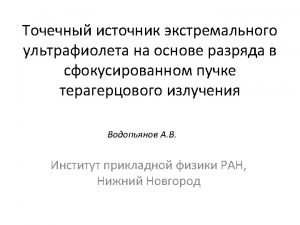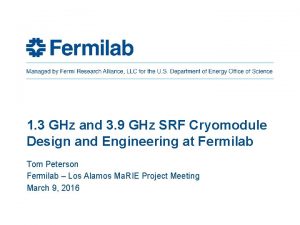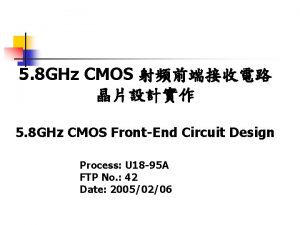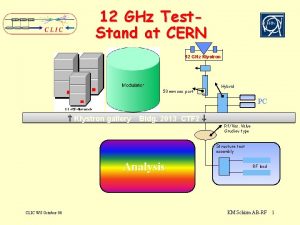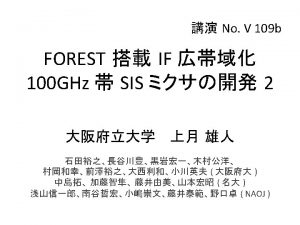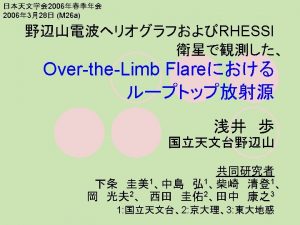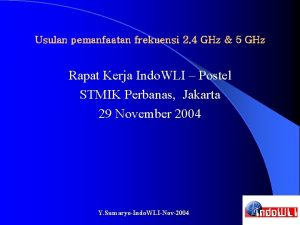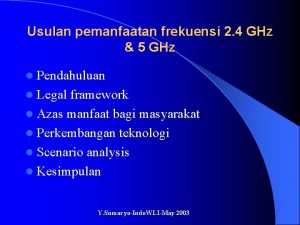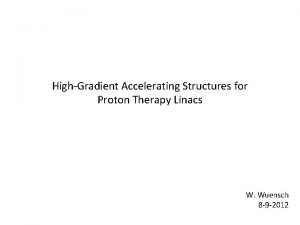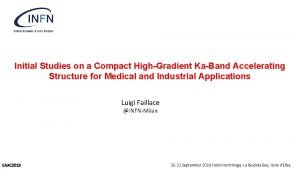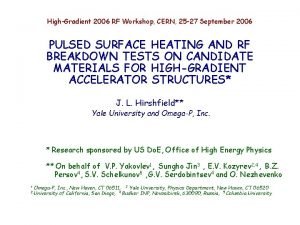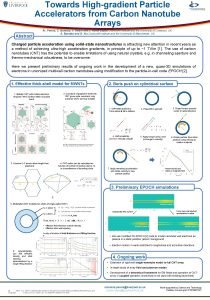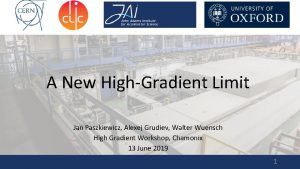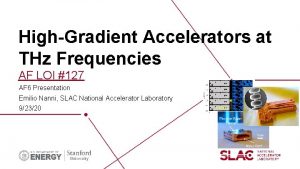30 GHz highgradient results 30 GHz history Recent






























- Slides: 30

30 GHz high-gradient results • 30 GHz history • Recent 30 GHz results • Frequency dependence • Conclusions and Outlook Steffen Döbert, X-band workshop KEK, May 2008

Damage in high field areas Copper Tungsten

Clamped-Iris Structure Tests in CTF II

Accelerating Structure Tests in CTF II Short, 16 ns rf pulses New Record for classical accelerating structures !

Overview of 30 GHz results Reached nominal 30 GHz CLIC values : 150 MV/m 70 ns Molybdenum shows higher gradient but different slope HDS performs worse than round brazed structure

Accelerating Structures made out of milled quadrants HDS 60

Damage vs aperture or group velocity HDS 60 Large HDS 60 Small Evidence for correlation between damage and power flow (a, vg, P): Criteria for optimizing rf designs (P/C): Px(t 1/3)/p/2 a < threshold

New Materials for High-Gradient Copper has still the best performance at low break down rate

Parameters for 30 GHz test strcutures

HDS 4_thick results, 70 ns

HDS 4_thick post mortem

NDS 4_thick vs HDS 4_thick

Short phase advance: C 40 vg 8_pi/2

Summary of 30 GHz results All measured data at 70 ns pulse length and 10 -3 breakdown rate Structure 2 a (mm) P (MW) E (MV/m) PT 1/3/C (wue) C 30 vg 4. 7 3. 5 20. 2 92 7. 5 HDS 60 vg 8. 0 3. 8 16. 1 61 5. 6 HDS 60 vg 5. 1 3. 2 13. 3 75 5. 5 C 40 vg 7. 4_pi/2 4. 0 19. 2 65 6. 2 HDS 4 vg 2. 6_thick 3. 5 7. 5 67 2. 8 NDS 4 vg 2. 5_thick 3. 5 8. 6 75 3. 2

Results from the HDX 11 high power test in NLCTA at SLAC Scaled version of HDS 11 small

HDX 11_Mo Conditioning history 40 ns 70 ns 50 ns 70 ns

Hybrid damped structures (HDX) at x-band Frequency scaling Scaled structures show very similar performance HDS-type structures show consistently limited performance no significant difference between Copper and Molybdenum

Frequency scaling experiment of 3. 5 mm round Again frequency scaling not inconsistent Slope most likely due to iris clamping

Relevance of 30 GHz tests for x-band • Get data on frequency scaling • Scaled structures show very similar performance • Economical high power testing (exotic ideas, materials) • Additional testing slots • Breakdown physics studies

Conclusions 30 GHz results are relevant for CLIC at x-band Some doubts on P/C theory (prediction of tested structures including those optimized with this assumptions, new developments on theories) Quadrant technology appears not mature (alignment, surface quality, performance) Short phase advance seems not beneficial Copper still best material Concentrate on round brazed structures and aperture dependence Most likely we will stop 30 GHz testing at the end of this year

The End Spare slides

30 GHz break down R&D program in CTF 3 Possible list of 30 GHz experiments -HDS 4_vg 2. 6_thick retest -HDS 11_vg 2 (clear P/C experiment without other changes) -C 30_vg 4. 7_sb (speed bump) -C 30_vg 2. 6 (P/C) - HDS 4_vg 2. 6_thick_clean (compares cleaning with previous) - NDS 4_vg 3. 6_thin (iris thickness in comparison with NDS 4_thick) - C 30_vg 8. 2 (P/C) - C 30_vg 2_TM 02 (vg) - HDS 11 copper/molybdenum (for better statistics)

Structure Testing Program for 2008

30 GHz flow chart 2007 HDS 4_vg 2. 6_thick (negative test result ? ) NDS 4_vg 2. 5_thick (negative test result) C 30_vg 4. 7_quad (not useable) Quads or slot are 2008 not a problem Input for x-band Quads or slot are a problem P/C ok HDS 11_vg 2 C 30_vg 2. 6 HDS 4_vg 2. 6_thick_clean C 30_vg 8. 2 NDS 4_vg 3. 6_thin New ideas if needed C 30_vg 4. 7_sb C 30_vg 2_TM 02

NDS 4_vg 2. 4_thick conditioning

Conditioning history HDS 4_vg 2. 6_thick

C 40 vg 7. 5_pi/2 Original motivation: shorter phase advance, lower surface field gain back in aperture similar surface field to accelerating field ratio by bigger aperture, higher vg and higher power Old structure from 2002, cleaned after being exposed to air since fabrication. New motivation: Bad results with short phase advance structures HDS series, test of phase advance and P/C

Summary of 30 GHz results in 2007 Probing phase advance and P/C theory

NDS 4_vg 2. 5_thick result

Hybrid Damped Structure (HDS) CLIC damped and detuned accelerating structure: 30 GHz, 150 MV/m, 70 ns, < 10 -6 trip probability
 A friend emails you the results
A friend emails you the results Compaq presario pentium 2
Compaq presario pentium 2 220 mhz transverter
220 mhz transverter From 12 to 140 ghz
From 12 to 140 ghz Recent trends in ic engine
Recent trends in ic engine Recent developments in ict
Recent developments in ict Recent developments in object detection
Recent developments in object detection Is college worth it synthesis essay
Is college worth it synthesis essay Recent trends in foreign trade
Recent trends in foreign trade Reading scanning
Reading scanning Recent trends in project management
Recent trends in project management Recent demographic changes in the uk
Recent demographic changes in the uk Myips online
Myips online Biotaphonomy
Biotaphonomy In a recent car accident tamiko
In a recent car accident tamiko Recent advances in ceramics
Recent advances in ceramics Passive voice headlines
Passive voice headlines Http drive google com
Http drive google com Udin generate icsi
Udin generate icsi Emerging trends in mis
Emerging trends in mis Mpgu
Mpgu Also history physical
Also history physical Results of the world war 1
Results of the world war 1 Epyg 2019 results
Epyg 2019 results Velocity saturation formula
Velocity saturation formula Vce statement of results
Vce statement of results Conclusion
Conclusion Utma ut
Utma ut Vietnam tunnels
Vietnam tunnels Stroop effect results table
Stroop effect results table Ainsworth 1978
Ainsworth 1978

